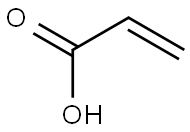
79-10-7
| Name | Acrylic acid |
| CAS | 79-10-7 |
| EINECS(EC#) | 201-177-9 |
| Molecular Formula | C3H4O2 |
| MDL Number | MFCD00004367 |
| Molecular Weight | 72.06 |
| MOL File | 79-10-7.mol |
Chemical Properties
| Appearance | Acrylic acid is a colorless, flammable, and corrosive liquid or solid (below 13 C) with an irritating, rancid, odor. Sinks and mixes with water; irritating vapor is produced. |
| Melting point | 13 °C(lit.) |
| Boiling point | 139 °C(lit.) |
| density | 1.051 g/mL at 25 °C(lit.) |
| vapor density | 2.5 (vs air) |
| vapor pressure | 4 mm Hg ( 20 °C) |
| refractive index | n |
| Fp | 130 °F |
| storage temp. | 15-25°C |
| solubility | 1000g/l |
| form | Liquid |
| pka | 4.25(at 25℃) |
| color | Clear |
| Odor | Acrid odor |
| PH | 2.1 (72.06g/l, H2O, 20℃) |
| PH Range | 1 - 2 |
| Stability: | Stability Unstable-may contain p-methoxyphenol as an inhibitor. Prone to hazardous polymerization. Combustible. Incompatible with strong oxidizing agents, strong bases, amines. Contact with oxidizers may cause fire. Light and air sensitive. Hygroscopic. |
| explosive limit | 3.9-19.8%(V) |
| Water Solubility | MISCIBLE |
Safety Data
| Hazard Codes | C,N |
| Risk Statements | |
| Safety Statements | |
| RIDADR | UN 2218 8/PG 2 |
| WGK Germany | 1 |
| RTECS | AS4375000 |
| F | 8-13 |
| Autoignition Temperature | 744 °F |
| TSCA | Yes |
| HazardClass | 8 |
| PackingGroup | II |
| HS Code | 29161110 |
| Safety Profile | |
| Hazardous Substances Data | 79-10-7(Hazardous Substances Data) |
| Toxicity |


